
Features
Production
Research
Growers hear the latest in tree fruit research
January 12, 2010 By Hugh McElhone
Cedar Springs Research Station near Blenheim, Ont., was the sight of a tree fruit field day this past summer, highlighting apple, peach, pear, plum and cherry production research. Growers and industry members had an opportunity to learn more about breeding programs, different cultivars being developed and tested, plus new approaches to crop production, including mechanical and chemical thinning.
Cedar Springs Research Station near Blenheim, Ont., was the sight of a tree fruit field day this past summer, highlighting apple, peach, pear, plum and cherry production research. Growers and industry members had an opportunity to learn more about breeding programs, different cultivars being developed and tested, plus new approaches to crop production, including mechanical and chemical thinning.
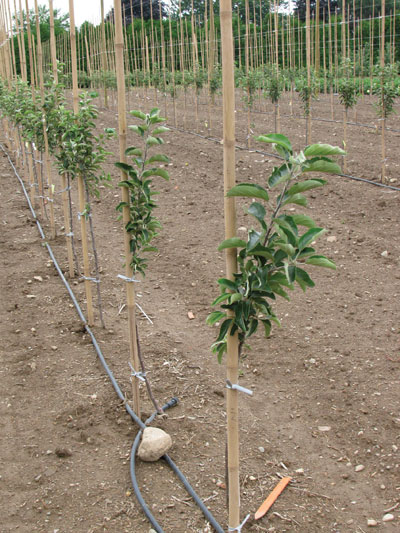 |
|
| Apple varieties from across Canada and parts of the U.S. are currently on trial at the Cedar Springs Research Station. |
|
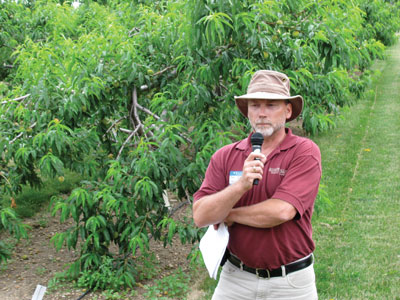 |
|
| University of Guelph research horticulturist John Zandstra discusses a high-density peach production trial, during the 2009 tree fruit field day held this past summer at the Cedar Springs Research Station. |
|
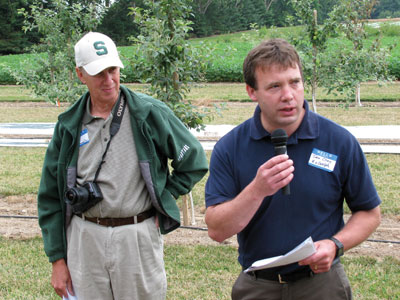 |
|
| Phil Schwallier (left), district horticulture educator for Michigan State University, and Dr. John Cline, an associate professor and apple expert with the University of Guelph, discuss apple thinning. |
|
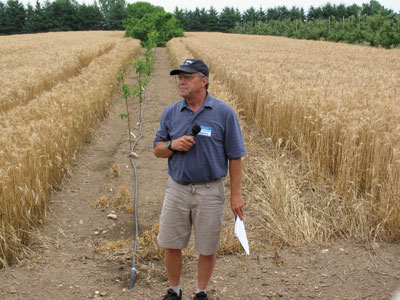 |
|
| Ken Slingerland, a tender fruit and grape specialist with the Ontario Ministry of Agriculture, Food and Rural Affairs (OMAFRA), discusses his research work during a stop on the tour. |
|
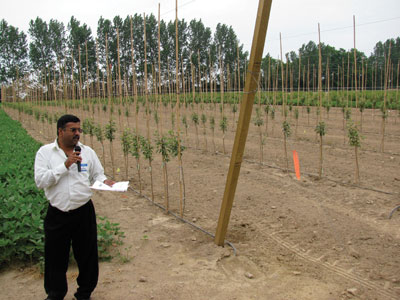 |
|
| Dr. Jay Subramanian, a stone fruit breeder with the University of Guelph, describes the newest cultivars being tested at the Cedar Springs Research Station. Advertisement
|
The first stop on the wagon tour occurred at the high-density peach production trial, where the Vulcan and Virgil cultivars are planted at a six-, eight- and 10-foot spacing on 18-foot rows.
“Peaches do not like the central leader system,” explained John Zandstra, a research horticulturalist with the University of Guelph and based at Ridgetown, Ont. “They tend to do their own thing.” For ease of picking, production managers try to shape two scaffolds at the bottom during pruning, which can be difficult to do, he noted.
Increased yield per acre is the primary objective in the high-density peach production trial. “Neil Miles (a retired researcher with the University of Guelph) thought 15 tons per acre was possible, but the most we’ve gotten so far is 11 to 12 tons,” said Zandstra, adding this was achieved on a six-foot spacing. Trailing not far behind, the eight- and 10-foot spacings can achieve yields in the area of eight to 10 tons.
With no canning plants in Ontario, processing peaches at the research station are shipped to Michigan for processing. It is important to get the grades the processor wants, said Zandstra, as well as the right peach. Processors do not want Vulcan peaches.
Peaches were first planted in Ontario is 1748, and Zandstra would like to see long-term peach production continue. “There is strong demand in this market.”
Mechanical blossom thinning is more successful in peaches than in apples, said Ken Slingerland, a tender fruit and grape specialist with the Ontario Ministry of Agriculture, Food and Rural Affairs (OMAFRA), based in Vineland, Ont.
This past spring, researchers tested a thinning machine shipped to the province from Europe. About 10 farms across Ontario, from Cedar Springs to Collingwood, took part in the demonstration. Rotating nylon cords spinning at a high rate of speed are used to remove blossoms as the thinning machine sweeps through the orchard. Slingerland said producers could do 10 to 15 acres per day using a mechanical thinning machine. Orchards thinned during the demonstration achieved a 40 to 50 per cent success rate, which amounts to a considerable saving in labour costs, he added.
Among the peach cultivars from New Jersey being assessed at Cedar Springs is Gloria, a mid-to-late season performer with a firm fruit that is high in sugar and low in acid. For late season, Messina produces a large, firm peach that stores well. Desiree produces an early season, semi-freestone peach that is medium in size and highly coloured.
University of Guelph stone fruit breeder Dr. Jay Subramanian has some of his own in-house breeding selections planted at the research station. Among his unnamed, numbered selections holding promise is a medium-size, early producer that was ready for eating that day. Another, a large, white flesh peach being tested in Vineland, fared well in the taste trial though it has a tendency to bruise if abused. One other standout is a late season variety, similar to Gloria, that is large, red/yellow in colour and will store up to six weeks.
Dr. Subramanian said he also has two promising sweet cherry cultivars. One was ready for picking by June 30 at the Vineland station and resists cracking. The second, a white cherry, is being evaluated for niche markets but appears to have a tendency for cracking.
Three varieties of plums are also being tested. The golden plum has a brix level of 20 versus the norm of 15, and has big market potential, said Dr. Subramanian. “Our blue plum program is one of the best in the world. Many countries want our cultivars,” he said. One of those blue plum cultivars was recently released to the U.K.
New apple cultivars are also being assessed at eight sites across the province, explained Leslie Huffman, apple specialist with OMAFRA who is based at Harrow. “We have over 70 selections from around the world,” she said, and the blocks are now eight years old, a good age for determining which cultivars are good performers.
Huffman’s crew is also investigating apple replant disease. Roughly 3,000 acres of old orchards have been removed under a replant project but that land may still have the diseases and fungi associated with apples. “We will study these sites and see what happens,” she said. They will also try bio-fumigant cover crops to see if they are effective.
According to Phil Schwallier, district horticulture educator for Michigan State University, the chemical thinning of apple blossoms is “a difficult science to practice.” Products such as Ethrel work best when applied at the 10 mm stage, and in warm temperatures of 75 to 80 F, he added.
“It was a cool season this year so there were poor thinning results,” said Schwallier. In Michigan, it took three weeks after spraying to see any results. Cool, cloudy weather stresses the tree, and chemical thinning adds further stress that the tree cannot recoup through photosynthesis, he explained.
For fire blight suppression in apples, Schwallier said Apogee will reduce vegetative growth by 30 to 50 per cent, and suppress fire blight infections and canker growth by 50 per cent. The first spray should be applied at King bloom petal fall. “There are many definitions of petal fall,” he said. King bloom means the whole tree is in full bloom, and there may be some petals that haven’t fallen.
If fire blight has already moved in, it generally takes two weeks for Apogee to have an effect at the high rate. Apogee works only on contact and is not systemic. Schwallier also advised never using Apogee on Empire as it will crack the fruit.
On the pear front, Dr. David Hunter, with Agriculture and Agri-Food Canada (AAFC) in Vineland, said that with the loss of the processing industry in Ontario, many Bartlett pears went to the grocers. “We need new cultivars for this market, ideally ones that have fire blight resistance,” he said.
New cultivars are being evaluated and some selections have been sent to B.C. for testing. Dr. Hunter said they have several selections that are in the final stage of evaluation, and he expects three will be released in the next couple of years.
Slingerland added he would like to see a high-density trial undertaken for pears. He observed that there are too many grapes in Ontario, and there are lots of peaches being planted, so perhaps pears are an option for growers. “Pears are a bright spot that I can see in the next few years,” he said.
Print this page